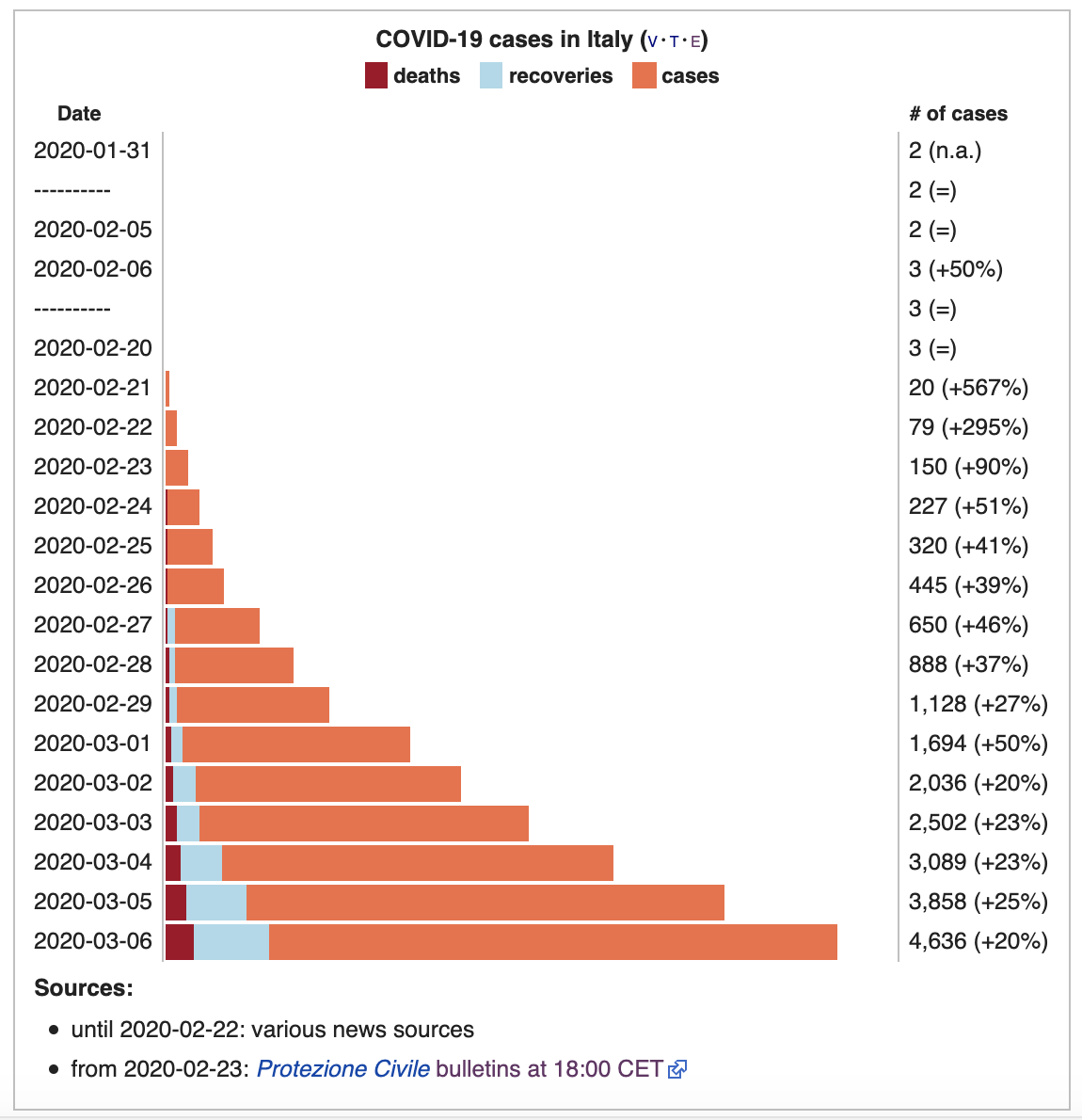Coronavirus: On responding to a rare pandemic danger, and preventing systemic risk
The last 3 days I've been hesitating to post this text, hoping I would see some signs of improvement. Given the current trajectory of things, I invite you to read the post as a minimal civic duty to our families, friends, and the communities we live in.
Perhaps the chief reason why we ought to reconsider the severity of the Coronavirus situation, is not personal risk(though this exists, especially for older people), but rather identifying and preventing a systemic risk. The disproportionately negative impact we could see in the coming weeks, is not only due to the high number of #COVID19 cases we will observe, but counter-intuitively, rather due to the powerful and cumulative second-order effects, which can paralyze a country, once a critical mass of people is contaminated.
I note below some of the most relevant data, based on different studies, added with reference links for verification.
The number of #COVID19 cases are constantly increasing around the world. Below is a map with relatively updated data. The reported COVID19 cases are ~102.469, with 3491 deaths, and ~57,444 recovered[1].
In the initial phase of Corona outbreak, Nassim Taleb - one of the foremost experts in studying risk[2] - has published a paper[3] in which he outlines a few severe errors which lead to gravely underestimating how the epidemy will evolve:
Historic examples of pandemic spreading are irrelevant given the unprecedented hyperconnected level of transportation we have achieved. Essentially, the virality of a pathogen, depends on the level of interaction between agents in a physical space. Given the hyper connectedness and high interaction between agents in 2020, extrapolation of previous models for pandemic evolution will manifest a severe bias of underestimating the speed of spreading[4].
Estimates about virality, as measured by the rate of reproduction R0 - meaning the number of people any infected person will infect, on average, during the infection period - are also underestimated due to a "fat tail"[5] statistical characteristic of a "super spreaders" group, which drastically alters statistical distribution once discovered.
The mortality rate is also underestimated, due to delays in reporting between the phase of detection, death, and reporting of the death.
3. Confirming the above, there's a recent study showing that the real virality(rate of reproduction R0) of COVID19, is between 4.4 and 6.6[7], meaning 4-5 times more severe than initially reported.
4. By extrapolating the rapid and unexpected spread in Italy[8][9], we can anticipate that the same scenario will be replicated in a majority of countries where detected Corona cases are not treated with proper caution and measures.
5. One of the most important indicators suggesting the spreading speed of an epidemy, is the doubling rate of cases. China showed a doubling rate of 1,8 days before implementing heavy quarantine measures[10], while Korea and Italy seem to double cases every 3 days right now[11][12]. The implications are profound[13]. If you start from 4600 cases(Italy yesterday) and double them every 3 days for only 4 weeks, you reach 2,355,200 cases(!).
It follows that, given the unprecedented connectivity, high virality of COVID19, high rate of interaction between agents, delay with which data can be processed, it is necessary to recognize this as a potential systemic risk and act in a timely manner. Furthermore, there is a precisely calculable point of critical mass, which once contaminated(even with a rate of mortality zero), will overwhelm the medical system of any country to the point of paralysis, setting off a domino effect, with potentially severe social and economic consequences. A quick calculation shows that in Romania, the situation will begin to overwhelm the system once a few thousand people will require medical care in a relatively short time frame, reaching the point of incapacity as the number nears 10.000.
Inescapable conclusions?
1. What differentiates this situation fundamentally from previous ones, is that given hyperconnectivity, any epidemy with high virality unchecked in time, will invariably become a pandemic. Thus, caution dictates that given the proportions of the potential danger, our only open option to minimizing the impact is to behave as though the epidemy is on the verge of becoming a pandemic already.
2. It becomes clear that in lack of an antidote, the most important component we have to control in order to prevent or stop a pandemic, is the rate of interaction between contaminated agents. Thus it becomes necessary to employ a set of drastic and sophisticated measures(see China's example) which go well beyond the reactive and individual ones, like detection based on symptoms, self quarantine, and situation monitoring.
Indeed, necessary general measures will likely have to include:
Limiting mobility in a relatively early phase of the epidemy and drastically pruning the number of people we come in contact with
Limiting the rate of interaction between people through collective measures(i.e. temporary closure of kindergartens/schools/universities)
Changing various social behaviours(i.e. avoiding to go in public spaces with above 10 people gathered)
Implementing methods of auto monitoring and reporting for the community
Finally, it's important to understand that we can still change things. But failure to reevaluate the severity of the situation, and acting in a timely manner, could end up costing us enormously. Governments should take immediate measures to forming teams for monitoring and preventing pandemic risc, so they can eventually slow down the spreading. Time is of essence in this situation.
---
References:
[1] - https://gisanddata.maps.arcgis.com/…/opsdashboa…/index.html…
[2] - https://en.wikipedia.org/wiki/Nassim_Nicholas_Taleb
[3] - https://www.academia.edu/…/Systemic_Risk_of_Pandemic_via_No…
[4] - https://medium.com/…/transition-to-extinction-pandemics-in-…
[5] - https://en.wikipedia.org/wiki/Fat-tailed_distribution
[6] - https://en.wikipedia.org/wiki/Super-spreader
[7] - https://www.medrxiv.org/conte…/10.1101/2020.02.07.20021154v1
[8] - https://en.wikipedia.org/…/2020_coronavirus_outbreak_in_Ita…
[9] - https://en.wikipedia.org/…/Templa…/Italy_medical_cases_chart
[10] - https://link.springer.com/arti…/10.1007%2Fs15010-020-01401-y
[11] - https://www.channelnewsasia.com/…/south-korea-covid-19-case…
[12] - http://timesofsweden.com/wp-cont…/…/2020/02/italy-corona.png
[13] - https://en.wikipedia.org/wiki/Wheat_and_chessboard_problem
